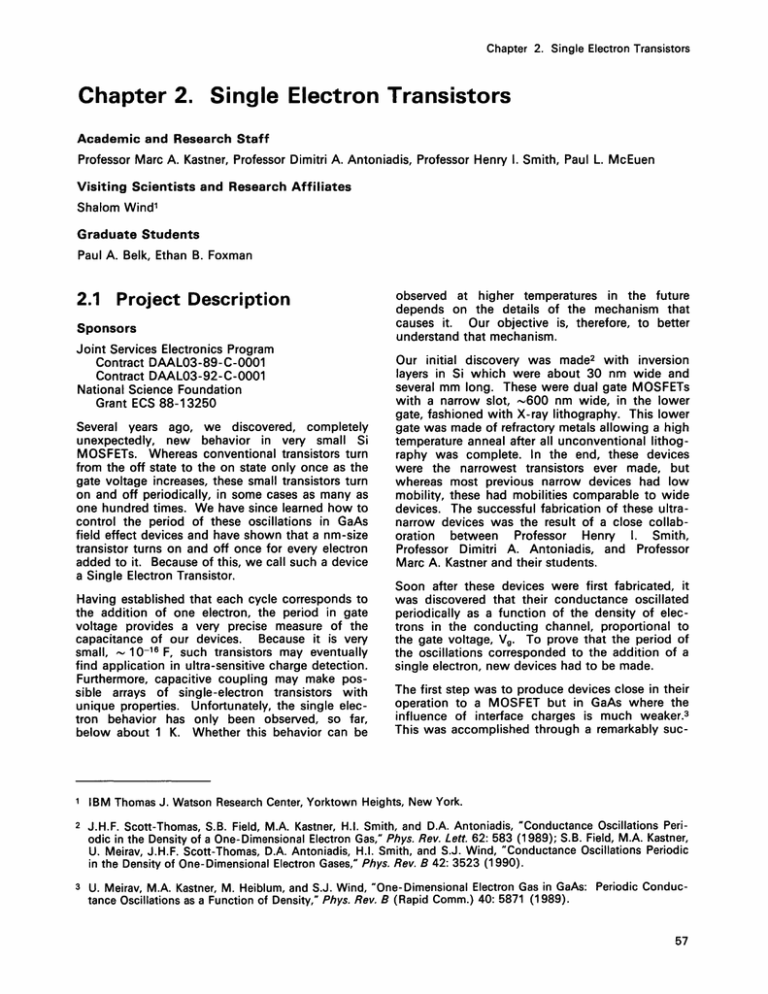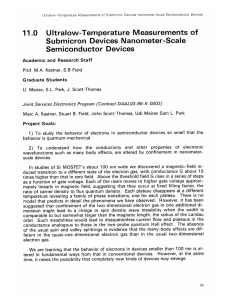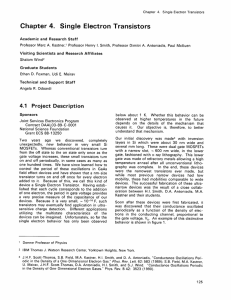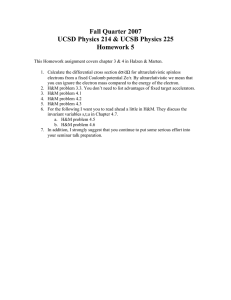Chapter 2. Single Electron Transistors L.
advertisement

Chapter 2. Single Electron Transistors Chapter 2. Single Electron Transistors Academic and Research Staff Professor Marc A. Kastner, Professor Dimitri A. Antoniadis, Professor Henry I. Smith, Paul L. McEuen Visiting Scientists and Research Affiliates Shalom Wind 1 Graduate Students Paul A. Belk, Ethan B. Foxman 2.1 Project Description Sponsors Joint Services Electronics Program Contract DAAL03-89-C-0001 Contract DAAL03-92-C-0001 National Science Foundation Grant ECS 88-13250 Several years ago, we discovered, completely unexpectedly, new behavior in very small Si MOSFETs. Whereas conventional transistors turn from the off state to the on state only once as the gate voltage increases, these small transistors turn on and off periodically, in some cases as many as one hundred times. We have since learned how to control the period of these oscillations in GaAs field effect devices and have shown that a nm-size transistor turns on and off once for every electron added to it. Because of this, we call such a device a Single Electron Transistor. Having established that each cycle corresponds to the addition of one electron, the period in gate voltage provides a very precise measure of the capacitance of our devices. Because it is very small, '" 1 0- 16 F, such transistors may eventually find application in ultra-sensitive charge detection. Furthermore, capacitive coupling may make possible arrays of single-electron transistors with unique properties. Unfortunately, the single electron behavior has only been observed, so far, below about 1 K. Whether this behavior can be observed at higher temperatures in the future depends on the details of the mechanism that causes it. Our objective is, therefore, to better understand that mechanism. Our initial discovery was made 2 with inversion layers in Si which were about 30 nm wide and several mm long. These were dual gate MOSFETs with a narrow slot, ",600 nm wide, in the lower gate, fashioned with X-ray lithography. This lower gate was made of refractory metals allowing a high temperature anneal after all unconventional lithography was complete. In the end, these devices were the narrowest transistors ever made, but whereas most previous narrow devices had low mobility, these had mobilities comparable to wide devices. The successful fabrication of these ultranarrow devices was the result of a close collaboration between Professor Henry I. Smith, Professor Dimitri A. Antoniadis, and Professor Marc A. Kastner and their students. Soon after these devices were first fabricated, it was discovered that their conductance oscillated periodically as a function of the density of electrons in the conducting channel, proportional to the gate voltage, Vg • To prove that the period of the oscillations corresponded to the addition of a single electron, new devices had to be made. The first step was to produce devices close in their operation to a MOSFET but in GaAs where the influence of interface charges is much weaker. 3 This was accomplished through a remarkably suc- 1 IBM Thomas J. Watson Research Center, Yorktown Heights, New York. 2 J.H.F. Scott-Thomas, S.B. Field, M.A. Kastner, H.1. Smith, and D.A. Antoniadis, "Conductance Oscillations Periodic in the Density of a One-Dimensional Electron Gas," Phys. Rev. Lett. 62: 583 (1989); S.B. Field, M.A. Kastner, U. Meirav, J.H.F. Scott-Thomas, D.A. Antoniadis, H.1. Smith, and S.J. Wind, "Conductance Oscillations Periodic in the Density of One-Dimensional Electron Gases," Phys. Rev. B 42: 3523 (1990). 3 U. Meirav, M.A. Kastner, M. Heiblum, and S.J. Wind, "One-Dimensional Electron Gas in GaAs: Periodic Conductance Oscillations as a Function of Density," Phys. Rev. B (Rapid Comm.) 40: 5871 (1989). 57 Chapter 2. Single Electron Transistors -- 10-2 ...c. ........... - N Q) Q) u c 10-3 0 -+-J U ::;) ""0 C 0 u 10-4 10-5 0.280 0.285 0.290 Vback gate 0.295 0.300 (V) Figure 1. Conductance in units of the quantum of conductance e2 Jh versus voltage on the n+GaAs substrate, the "back gate." On the logarithmic plot it is clear that the transistor has an on-to-off conductance ratio that exceeds 103 for the lowest gate voltages. The measurements were made at 30 mK with a source-drain voltage of only 2.5 J-N. cessful collaboration with M. Heiblum of IBM. The new structure was created by growing AIGaAs on a conductive substrate, followed by a layer of undoped GaAs. The electron density at the GaAs/AIGaAs interface, inverted from the usual configuration, was varied by applying a voltage to the substrate. Heiblum was able to grow such inverted heterojunctions with mobilities of - 500,000cm 2 /V-s. Next, the conducting channel is defined by depositing a metal gate on top of the GaAs, and a gap is patterned in the gate by electron beam lithography. Because a depletion region is created under the gate, the electrons accumulate only under the gap. In order to emulate the effect of two charged impurities, two constrictions are patterned in the gap. The electron beam lithography was done at IBM with the help of Shalom Wind. 4 58 Devices of this kind worked exactly as we hoped they would. 4 Periodic oscillations of the conductance were seen again, but now they were controlled: The period was the same for different devices with the same spacing between constrictions and was larger when the spacing was shorter, consistent with the idea that the same number of electrons is added for one period in all devices. Calculations of the capacitance of such devices are only consistent with each period corresponding to one electron added per oscillation. This is an amazing result: Figure 1 shows that the conductance consists of periodic, narrow, wellseparated resonances. The conductance rises and falls by a factor -1000 with a variation of gate voltage that corresponds to only -1/3 of an electron. U. Meirav, M.A. Kastner, and S.J. Wind, "Single Electron Charging and Periodic Conductance Resonances in GaAs Nanostructures," Phys. Rev. Lett. 65: 771 (1990). RLE Progress Report Number 134 Chapter 2. Single Electron Transistors We now understand quite well why the Single Electron Transistor works the way it does. The conductance results from resonant tunneling, and Professor Patrick Lee and his collaborators have shown that the states arise from single particle quantum states (the Fabry- Perot states induced by the two barriers, the same as expected for any "quantum dot"), but that the energies of the levels are dominated by the Coulomb interaction between the electrons in the isolated segment. Experiments in the quantum Hall regime 5 at first seemed to indicate that the nature of the quantum states was very simple. By measuring the position in gate voltage of a series of conductance resonances, we were able to measure the energies for adding a series of electrons as a function of magnetic field. Figure 2 shows (top panel) how the peak positions oscillated with magnetic field. Subtracting a constant Vg difference from each pair of curves we emulated the effect of subtracting a constant Coulomb energy. We thereby obtained the level spectrum shown in the lower panel. The level spectrum looks remarkably similar to that for non-interacting electrons in a magnetic field We and a confining electrostatic potential. thought, therefore, that the simple Coulomb blockade model, with a constant Coulomb interaction between any two electrons in the isolated region, was adequate. However, more careful analysis of data like that in figure 2 shows that this simple picture is inadequate. In particular, the difference in energies for electron spin parallel and antiparallel to the magnetic field are much too large in the experiment. Recently, a density functional model for the isolated region has been developed in collaboration with Professor Lee's group. The good agreement between the model and the experimental results shows that electrons in different spatial and even spin states have very different Coulomb interactions. This is a major step in deepening our understanding of the physics of single electron transistors. 5 Publications McEuen, P.L., E.B. Foxman, U. Meirav, M.A. Kastner, Y. Meir, N.S. Wingreen, and S.J. Wind. "Transport Spectroscopy of a Coulomb Island in the Quantum Hall Regime." Phys. Rev. Lett. 66: 1926 (1991). ! (a) _--.-.---- >0.145 - - - - - - 3 = .-! :3 0.143 .....--.__/"-.... . t _ _- - - 1__ l _ ------------.----1 --- --- -~ ~ ~ 0.141 .. ~ --~- - ...-.----------------- ~.....---.----------.- 0.. 1--..- - - - - - - - - (b) rn ] ~ ~ 0.1 o L...o..:.._ _l...-._ _""'-• _ _...L--_ _....'_ _----' 2.9 3.0 3.1 3.2 B-Field (T) 3.3 3.4 Figure 2. (a) The gate voltages corresponding to a series of consecutive conductance peaks like those in figure 1, as a function of magnetic field. (b) Result of subtracting a constant voltage from each successive peak in (a). This gives the energy for adding the next electron as a function of field with the average Coulomb interaction subtracted. The arrows follow a particular level as it moves through successive peaks. P.L. McEuen, E.B. Foxman, U. Meirav, M.A. Kastner, Y. Meir, N.S. Wingreen and S.J. Wind, "Transport Spectroscopy of a Coulomb Island in the Quantum Hall Regime," Phys. Rev. Lett. 66: 1926 (1991). 59 Professor Patrick A. Lee 60 RLE Progress Report Number 134




